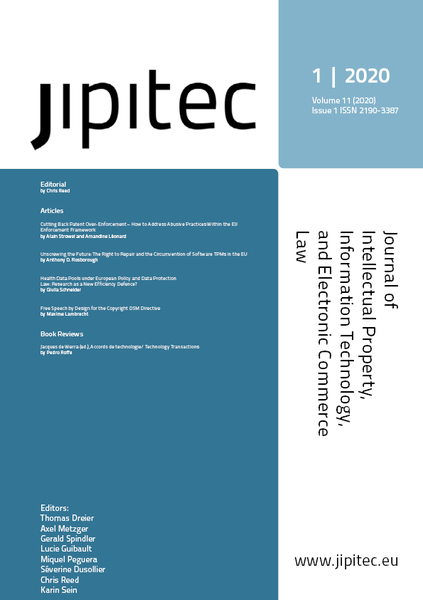Unscrewing the Future: The Right to Repair and the Circumvention of Software TPMs in the EU
Keywords:
EU competition law, European Union, Intellectual property rights, circumvention, compulsory licensing, copyright, right to repair, secondary market, software, technological protection measuresAbstract
This analysis examines the impact of software technological protection measures (“TPMs”) in the European Union which inhibit the repair and maintenance of products. Using John Deere tractors as a case study, this analysis addresses the growing number of products which incorporate computerisation and TPM-protected software into their design and function. In utilising software integration and TPMs, many product designs now allow manufacturers to retain considerable control over the manner of repair and choice of technician. In response, consumers and lawmakers are calling for legal reforms to make self-repair and servicing easier. Both the competition law and moral implications of this residual control held by manufacturers are examined in this analysis. The foregoing raises the question: what are the impediments to establishing a secondary market for repair of products which utilise software TPMs, and what are the implications of those impediments? The structure of the EU’s software TPM framework acts a major impediment to establishing a secondary repair market for these products. The implications of this impediment are both legal and moral. This analysis surveys the development of anti-circumvention law in the international and European contexts before assessing the impact of the US approach to anti-circumvention on global manufacturing and design techniques. In assessing the EU legal framework, the analysis focuses on the inconsequential and distinct legal status given to TPMs which protect software from other types of works. The inability to circulate the means of circumvention acts as a key impediment to establishing a secondary market for repair. Further, the inapplicability of copyright exceptions and limitations to software TPMs, and the legal prohibition on circulation of the means of TPM circumvention, jointly leave little room for proactive policymaking. Through these legal protections, manufacturers can escape the perceived threat posed by TPM circumvention tools and, by extension, undermine independent technicians’ ability to carry out their businesses. In assessing the John Deere case study, the analysis proposes that the refusal to allow circulation of the means of software TPM circumvention may constitute an abuse of a dominant position in the secondary market. In looking to jurisprudence in this area, the analysis explores the degree to which the refusal to provide the means of circumvention could amount to the denial of an essential facility which is indispensable for the secondary repair market. While some distinctions can be drawn between TPM circumvention and the types of intellectual property rights at issue in the EU competition law jurisprudence, the analysis proposes that the market effects are in many ways analogous. The analysis seeks to establish that consumers’ inability to conduct repairs to the products that they own is undesirable for a number of legal, moral and conceptual reasons. By prohibiting self-repair, software TPMs predetermine the relationship between technology, the law and society. This undermines the fostering of a morally responsible and technologically inclined citizenry which engages with and contributes to technological development. The analysis concludes with a call for a review of software TPM protections in the EU along with changes which could alleviate the foregoing market and moral implications while enabling consumers to assert their right to repair.Published
2020-04-01
Issue
Section
Artikel

